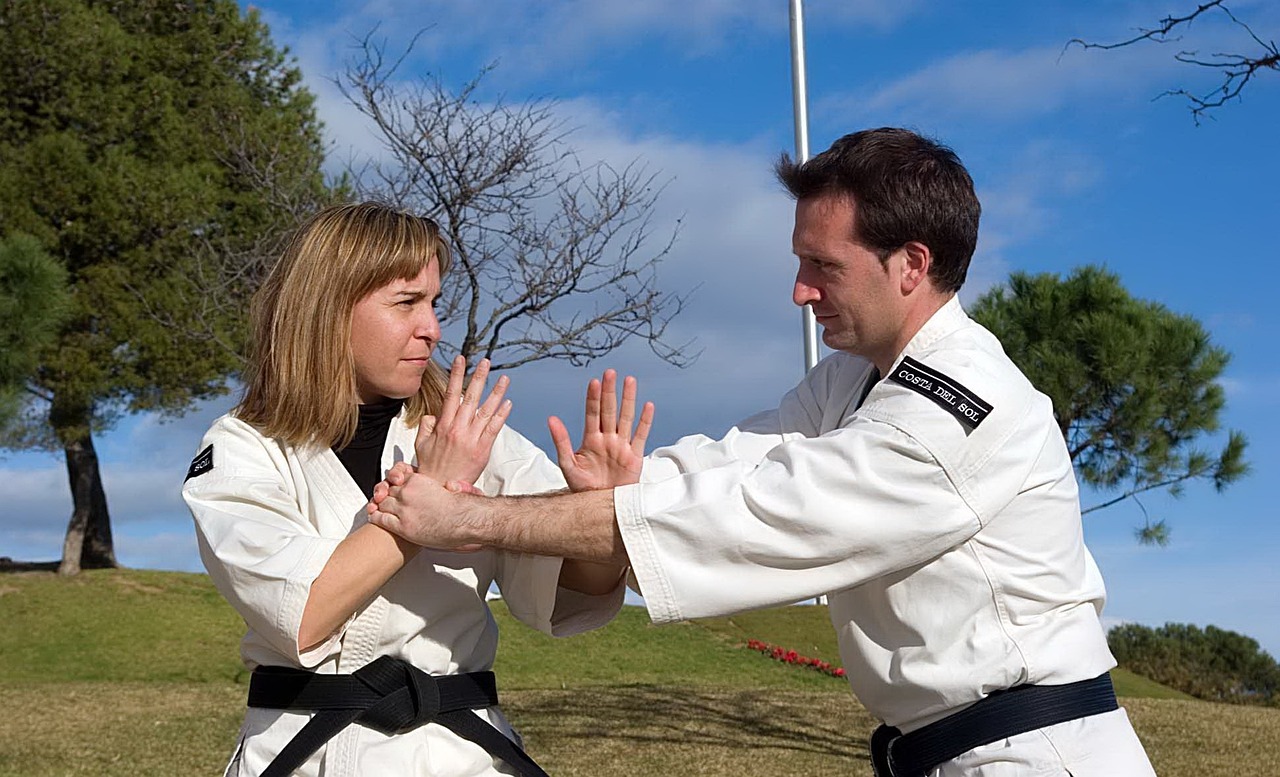In this article, you will discover a comprehensive overview of the most popular self-defense techniques that can empower you with the skills needed to protect yourself in any situation. From Krav Maga to Brazilian Jiu-Jitsu, we will explore the practicality and effectiveness of each technique, allowing you to make an informed decision on which one suits your needs best. Whether you are a beginner seeking to boost your self-confidence or an experienced martial artist looking to expand your skillset, this article will provide you with valuable insights and guidance on the path to self-defense mastery. So, let’s embark on this exciting exploration together and unlock the secrets of self-defense!

1. Krav Maga
Overview of Krav Maga
Krav Maga is a self-defense system developed for the Israeli military. It focuses on practical techniques that can be used in real-life situations. It was created by Imi Lichtenfeld, who drew upon his experience as a boxer and wrestler to develop a system that would be effective in both armed and unarmed combat. Krav Maga is known for its emphasis on rapid counter-attacks and its use of simultaneous defense and offense.
Techniques taught in Krav Maga
In Krav Maga, you will learn a wide range of techniques that are designed to be simple and effective. These include strikes, kicks, knee strikes, and elbow strikes, as well as defenses against punches, grabs, chokes, and weapons. Krav Maga also includes training in realistic scenarios, such as how to defend against multiple attackers or how to deal with threats in confined spaces.
Benefits of learning Krav Maga
Learning Krav Maga can provide you with a variety of benefits. First and foremost, it can give you the skills and confidence to protect yourself and others in dangerous situations. Krav Maga training can increase your physical fitness, flexibility, and strength. It can also improve your mental focus and discipline. Additionally, Krav Maga offers a supportive and welcoming community, where you can meet new people and build lifelong friendships.
Popularity of Krav Maga
Krav Maga has gained popularity worldwide due to its practical and effective approach to self-defense. It is widely recognized as one of the most efficient fighting systems, and its techniques are used by military and law enforcement units around the world. Krav Maga classes are now offered in many countries, making it accessible to people of all ages and fitness levels. Its popularity continues to grow as more individuals recognize the importance of being prepared for self-defense situations.
2. Brazilian Jiu-Jitsu
Overview of Brazilian Jiu-Jitsu
Brazilian Jiu-Jitsu (BJJ) is a martial art that focuses on ground fighting and grappling techniques. It was developed from traditional Japanese Jiu-Jitsu by the Gracie family in Brazil. BJJ is known for its emphasis on leverage and technique, allowing smaller individuals to overcome larger opponents. It is often referred to as the “gentle art” because it relies on using an opponent’s strength against them.
Techniques taught in Brazilian Jiu-Jitsu
In Brazilian Jiu-Jitsu, you will learn various techniques for controlling and submitting an opponent on the ground. These include joint locks, chokes, sweeps, and escapes. BJJ also places a strong emphasis on positional control and transitioning between positions. The goal is to gain a dominant position and submit your opponent using techniques such as arm bars, triangle chokes, and rear-naked chokes.
Benefits of learning Brazilian Jiu-Jitsu
Learning Brazilian Jiu-Jitsu offers numerous benefits. One of the key advantages is its effectiveness in real-life self-defense situations, particularly against larger and stronger opponents. BJJ also provides a full-body workout, improving strength, flexibility, and cardiovascular fitness. It enhances mental focus, problem-solving skills, and discipline. Additionally, BJJ fosters a supportive and tight-knit community, where students often develop close bonds with their training partners.
Popularity of Brazilian Jiu-Jitsu
Brazilian Jiu-Jitsu has seen a surge in popularity, both as a competitive sport and as a self-defense system. It has gained significant recognition through events such as the Ultimate Fighting Championship (UFC), where BJJ practitioners showcased their skills against various martial arts styles. BJJ academies have multiplied around the world, attracting individuals of all ages and genders. Many people are drawn to BJJ for its practicality, effectiveness, and the mental and physical challenges it presents.

3. Muay Thai
Overview of Muay Thai
Muay Thai, also known as the “Art of Eight Limbs,” is a striking-based martial art and combat sport from Thailand. It utilizes punches, kicks, elbows, and knee strikes, distinguishing it from other striking disciplines. With its strong emphasis on conditioning and relentless attacks, Muay Thai is often regarded as one of the most powerful and effective martial arts.
Techniques taught in Muay Thai
In Muay Thai, you will learn a wide range of striking techniques, including punches, kicks, knees, and elbows. You will also master various defensive techniques, such as blocking, parrying, and evading. Additionally, Muay Thai includes clinch work, where fighters engage in close-quarters combat, utilizing knee strikes and elbow strikes. The training involves pad work, bag work, and sparring, allowing practitioners to develop both offensive and defensive skills.
Benefits of learning Muay Thai
Learning Muay Thai offers numerous benefits beyond self-defense. It provides an intense full-body workout that improves cardiovascular fitness, strength, endurance, and flexibility. Muay Thai training also helps develop mental focus, discipline, and resilience. The dynamic and high-intensity nature of the sport is an excellent stress reliever and boosts self-confidence. Additionally, the welcoming and supportive community ensures a positive environment for learning and personal growth.
Popularity of Muay Thai
Muay Thai’s popularity has spread globally due to its effectiveness and its influence in combat sports, such as mixed martial arts (MMA). The aggressive and powerful striking techniques, combined with its rich cultural heritage, have captivated people from all walks of life. Muay Thai is now practiced in various countries, with many individuals drawn to its physical and mental challenges. Its popularity continues to grow as more people recognize the transformative benefits it offers.
4. Boxing
Overview of Boxing
Boxing is a combat sport that focuses on punches, footwork, and head movement. It involves a strict set of rules and is typically performed within a roped square ring. Boxing has ancient roots, dating back to ancient civilizations such as Egypt and Greece. It is known as the “sweet science” due to its technical and skill-based nature.
Techniques taught in Boxing
In boxing, you will learn a variety of punches, such as jabs, crosses, hooks, and uppercuts. Footwork, head movement, and defensive skills are also emphasized, allowing boxers to evade and counter their opponents. Boxing training involves shadowboxing, bag work, pad work, and sparring, providing opportunities to refine technique, speed, and accuracy.
Benefits of learning Boxing
Learning boxing offers numerous benefits beyond the sport itself. Boxing is a high-intensity workout that improves cardiovascular fitness, endurance, and coordination. It enhances upper body and core strength while promoting weight loss and muscle toning. Boxing also instills discipline, mental focus, and self-confidence. Additionally, it provides an outlet for stress relief and can be a powerful form of self-expression.
Popularity of Boxing
Boxing has maintained its popularity for centuries, being one of the oldest and most respected combat sports. Its rich history, iconic fighters, and global recognition through events like the Olympic Games and professional boxing matches have contributed to its enduring appeal. Boxing gyms can be found worldwide, catering to both competitive fighters and individuals looking to improve their fitness levels. Its popularity is further bolstered by the growth of fitness-oriented boxing classes, where participants can experience the physical and mental benefits of the sport in a non-competitive environment.

5. Taekwondo
Overview of Taekwondo
Taekwondo is a Korean martial art focused on high kicks, fast and dynamic movements, and strong, accurate strikes. It places importance on mental discipline and the development of a strong spirit. Taekwondo is recognized as an Olympic sport and a popular martial art for both self-defense and personal development.
Techniques taught in Taekwondo
In Taekwondo, you will learn a wide range of kicking techniques, including front kicks, roundhouse kicks, side kicks, and hook kicks. Hand strikes, blocks, and footwork are also integral parts of the training. Forms, known as “poomse” or “patterns,” help practitioners develop balance, coordination, and memory. Additionally, sparring allows students to apply their techniques in controlled combat situations.
Benefits of learning Taekwondo
Learning Taekwondo offers numerous physical and mental benefits. The practice improves flexibility, strength, and cardiovascular fitness. Taekwondo training also instills discipline, self-confidence, and perseverance. It enhances focus, self-control, and the ability to set and achieve goals. Additionally, practicing Taekwondo fosters respect, integrity, and camaraderie within the martial arts community.
Popularity of Taekwondo
Taekwondo’s popularity has grown significantly since its introduction as an Olympic sport in 2000. It is widely practiced around the world, with millions of individuals actively engaged in training and competing. The dynamic and visually impressive nature of Taekwondo, highlighted by powerful kicks and acrobatic movements, has drawn considerable attention. Many people are also attracted to its emphasis on self-discipline, personal growth, and the opportunity to compete at local, national, and international levels.
6. Kickboxing
Overview of Kickboxing
Kickboxing is a hybrid martial art that combines elements of boxing and various kicking techniques. It originated in Japan and the United States during the 1960s and has evolved into a popular combat sport and fitness activity. Kickboxing is known for its high-intensity workouts and emphasis on both striking and defense techniques.
Techniques taught in Kickboxing
In Kickboxing, you will learn a combination of punches, kicks, and knee strikes. It encompasses a wide range of strikes, from jabs and crosses to roundhouse kicks and front kicks. Footwork, defensive maneuvers, and clinch work are also taught. Kickboxing training involves bag work, pad work, and sparring, allowing practitioners to develop speed, power, and accuracy.
Benefits of learning Kickboxing
Kickboxing provides numerous physical and mental benefits. It offers a full-body workout that improves cardiovascular fitness, strength, and flexibility. Kickboxing enhances coordination, balance, and agility. It promotes self-confidence, discipline, and mental focus. Additionally, the high-intensity nature of kickboxing releases endorphins, reducing stress and increasing overall well-being.
Popularity of Kickboxing
Kickboxing has gained popularity worldwide due to its combination of cardiovascular exercise and effective self-defense techniques. It appeals to individuals seeking a challenging and dynamic workout that also enhances practical fighting skills. Kickboxing classes are offered in many gyms and fitness facilities, catering to individuals of all fitness levels. Its growing popularity is attributed to its appeal to both competitive athletes and individuals looking to improve their physical fitness and mental well-being.

7. Karate
Overview of Karate
Karate is a martial art that originated in Okinawa, Japan, and later spread throughout the world. It emphasizes powerful strikes, kicks, and knee strikes, along with blocks, evasions, and throws. Karate also places a strong emphasis on character development, self-discipline, and respect.
Techniques taught in Karate
In Karate, you will learn a variety of striking techniques, including punches, kicks, knee strikes, and elbow strikes. Hand strikes are executed with the knuckles, emphasizing power and precision. Karate also includes defensive techniques, such as blocks, redirects, and evasions. Katas, which are predetermined forms, allow practitioners to practice techniques in a structured manner.
Benefits of learning Karate
Learning Karate offers numerous physical and mental benefits. It improves strength, flexibility, and overall physical fitness. Karate training promotes discipline, self-confidence, and perseverance. It enhances mental focus, self-control, and the ability to manage stress. Additionally, Karate fosters a sense of community, encouraging respect, humility, and lifelong learning.
Popularity of Karate
Karate’s popularity has grown significantly over the years, fueled by its representation in pop culture and media. It is widely practiced and recognized as an Olympic sport. Many individuals are drawn to Karate for its emphasis on self-development, physical fitness, and practical self-defense techniques. Karate schools and dojos can be found worldwide, providing opportunities for people of all ages and backgrounds to train and progress in the art.
8. Wing Chun
Overview of Wing Chun
Wing Chun is a Chinese martial art that focuses on close-range combat and efficient, direct techniques. It emphasizes simultaneous attack and defense, using quick, precise strikes and blocks. Wing Chun is known for its simplicity and economy of movement, making it suitable for individuals of all ages and physical capabilities.
Techniques taught in Wing Chun
In Wing Chun, you will learn a range of striking techniques, including straight punches, palm strikes, and elbow strikes. Wing Chun also incorporates close-quarters combat, utilizing trapping and grappling techniques. The system emphasizes structure, allowing practitioners to develop a strong foundation for their techniques and movements.
Benefits of learning Wing Chun
Learning Wing Chun offers numerous benefits beyond self-defense. It enhances physical fitness, coordination, and reflexes. Wing Chun training also promotes mental focus, discipline, and mindfulness. The practice instills confidence and body awareness. Additionally, Wing Chun fosters a supportive and inclusive community, encouraging personal growth and lifelong learning.
Popularity of Wing Chun
Wing Chun has gained popularity globally, due in part to its association with iconic martial artist Bruce Lee. Its effectiveness in close-quarters combat and its adaptability to various body types and age ranges have made it a popular choice for self-defense training. Wing Chun schools and academies can be found in many countries, providing individuals with opportunities to learn and practice this versatile martial art.

9. Krav Maga
Overview of Krav Maga
Krav Maga, previously discussed in section 1, is a self-defense system developed for the Israeli military. It combines techniques from various martial arts and focuses on practical, real-life situations. Krav Maga training emphasizes rapid and aggressive counter-attacks.
Techniques taught in Krav Maga
As previously mentioned, Krav Maga teaches a wide range of techniques for both armed and unarmed combat situations. The techniques include strikes, kicks, knee strikes, elbow strikes, and defenses against various attacks and weapons. Krav Maga training also incorporates realistic scenarios, preparing practitioners to handle multiple attackers or threats in confined spaces.
Benefits of learning Krav Maga
Krav Maga provides numerous practical benefits for self-defense. It equips individuals with the skills and confidence to protect themselves and others in dangerous situations. The training improves physical fitness, strength, and flexibility. Krav Maga also enhances mental focus, quick decision-making, and the ability to handle stress. Additionally, the community aspect of Krav Maga fosters support, camaraderie, and personal growth.
Popularity of Krav Maga
As previously mentioned, Krav Maga has gained popularity worldwide due to its effectiveness and practical approach to self-defense. Its techniques are utilized by military and law enforcement units globally, further contributing to its recognition and popularity. The accessibility of Krav Maga classes and the growing awareness of the importance of self-defense have greatly increased its popularity among people of all backgrounds and fitness levels.
10. Judo
Overview of Judo
Judo is a modern Japanese martial art and Olympic sport that emphasizes throwing and grappling techniques. It was developed by Jigoro Kano in the late 19th century, based on traditional Japanese Jiu-Jitsu. Judo translates to “gentle way,” reflecting its principle of using an opponent’s energy against them.
Techniques taught in Judo
In Judo, the primary focus is on throws and takedowns, which involve using leverage and off-balancing an opponent. Ground fighting techniques, known as ne-waza, also play a crucial role. Judo practitioners learn a variety of throws, such as hip throws, shoulder throws, and foot sweeps. They also develop skills in pins, chokes, and joint locks.
Benefits of learning Judo
Learning Judo offers numerous physical and mental benefits. It enhances overall physical fitness, strength, and coordination. Judo training improves flexibility, agility, and reflexes. The practice also fosters mental discipline, focus, and problem-solving abilities. Judo cultivates respect, camaraderie, and humility within the martial arts community.
Popularity of Judo
Judo’s popularity has grown significantly, thanks to its inclusion in the Olympic Games and its effectiveness as a self-defense system. Many individuals are drawn to Judo for its emphasis on balance, technique, and the ability to overcome opponents using skill rather than sheer strength. Judo clubs and dojos can be found worldwide, catering to students of all ages and abilities. Its popularity continues to grow as people recognize the physical, mental, and competitive benefits it offers.
In conclusion, the popularity of various self-defense techniques can be attributed to their effectiveness, practicality, and the range of physical and mental benefits they offer. Whether you are looking for a practical self-defense system, a physically intense workout, or an opportunity for personal growth and self-discipline, there is a martial art that can meet your needs. From Krav Maga’s focus on rapid counter-attacks to the dynamic kicks of Taekwondo, each of these martial arts provides unique training experiences and opportunities for personal development. So, whatever your goals may be, there is a martial art waiting for you to explore and embark on a journey of self-discovery and empowerment.
